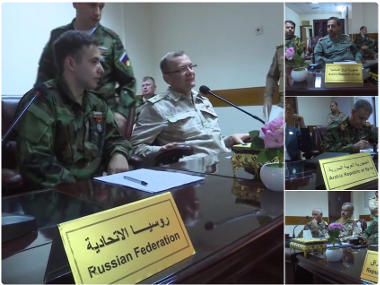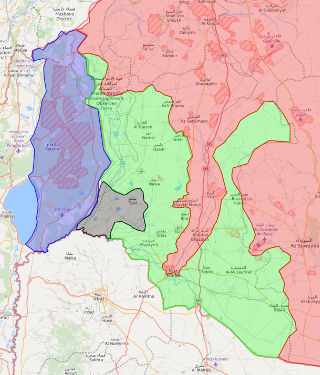
Syria - Damascus And Its Allies Prepare To Remove U.S. Forces From Al-Tanf
Moon of Alabama
June 22, 2018 "Information Clearing House" - On June 8 we asked if the then ongoing ISIS attack on Albu Kamal was part of a U.S. plan:
There is sneaking suspicion that the U.S. directed the ongoing ISIS attack on Abu Kamal to gain control over the crossing and to disable road supplies from Iran through Iraq into Syria....
The U.S. must be given no chance to use the ISIS pretext to take Abu Kamal. The Syrian government must rush to support its forces in the border city. It must immediately request that Iraqi forces cross the border from Al-Qaim and support the endangered Syrian troops.
Some reinforcement came in and Albu Kamal was soon back in Syrian government hands. The Syrian army also launched an operation to destroy ISIS positions in southeastern desert.

Southeast Syria (red: Syrian Army, green: U.S. zone around al-Tanf crossing to Iraq, grey: ISIS, yellow: U.S./Kurdish SDF) bigger
But U.S. interference in the east continued:
The Russian military is warning of a false-flag "chemical incident" in Deir Ezzor governorate. The Syrian Observatory reports that Islamic State remnants in the southeastern desert and in the Rukban camp, both under cover of the U.S. occupied zone around al-Tanf, prepare for a large attack on Syrian government forces. It claims that such an attack is an attempt to occupy the zone between al-Tanf and Albu Kamal at the Euphrates. Both operation would be planned diversions intended to draw Syrian forces away from Deraa and could provide excuses for U.S. intervention on the opposition side.
Late Sunday an airstrike destroyed a building in the Harri area near Albu Kamal directly on the Syrian-Iraqi border. The building was used as a headquarter for the Iraqi Popular Mobilization Forces (PMU) who are securing the border in coordination with the Syrian army in the fight against the Islamic State. More than 20 fighters were killed and more than 10 were wounded. This may have been in preparation for the reportedly planned large ISIS attack.
Another serious incident followed last night when U.S. supported Maghawhir al-Thawra "rebels" (which include 'former' ISIS fighters) attacked Syrian government forces:
A Syrian army officer was killed in a U.S strike on a Syrian army outpost near a U.S. base close to the Iraqi-Syrian border, a commander in the regional alliance supporting President Bashar al-Assad told Reuters.The Pentagon, said, however, that a U.S.-backed Syrian rebel group stationed in the Tanf garrison had engaged on Thursday evening an “unidentified hostile force” outside a “deconfliction zone” around the garrison, forcing it to retreat. It said there were no casualties on either side.
The Syrian Observatory claims that eight Syrian soldiers were killed in the attck. There is some footage of a desert chase with "technicals" that is supposed to be from these clashes. They took place in al-Halba, 70 kilometers northwest of al-Tanf and only 50 kilometers from Palmyra.
The U.S. sent "rebels" it trains at al-Tanf outside its self declared 55 kilometers deconfliction zone around Tanf to attack Syrian government forces. It supported them by air strikes. U.S. special forces are said to have taken part. This is likely the case as only U.S. special forces can call in such airstrikes.
It seems obvious that the U.S. is using ISIS, U.S. trained "Maghawhir al-Thawra" rebels, and its air power in another attempt to cut the land route between Syria and Iraq. It wants to use the upcoming Syrian campaign against al-Qaeda and ISIS in the southwest around Daraa to make a new move in the east.
But Syria and its allies will not allow that. They are building up their own forces in the east. As Elijah Magnier reported yesterday:
[D]uring my visit to the city of Palmyra and its surroundings, the presence of thousands of Russian troops is striking, indicating that Moscow is sending new infantry and special forces in very large numbers. This large presence has not been announced.
The Syrian army is also sending additional forces into the area and more Iraqi Popular Mobilization Units have arrived in the Al-Qaim/Albu-Kamal area.
Syria and its allies obviously decided to counter the U.S. move. Their operations at the Syrian-Iraqi border are coordinated by the common operation room in Baghdad.

bigger
Last night Syria, Iraq, Iran and Russia again discussed the situation in the east and made their decision:
SURA @AlSuraEnglish - 23:47 UTC - 21 Jun 2018#BREAKING - #Iraq, #Syria, #Russia and #Iran confirm new mission to secure the #Iraqi-#Syrian border from all terrorist groups. The mission was devised in the operations room in Iraq's capital, #Baghdad.

via Sura - Iraqi, Syrian, Iranian and Russian officers in the operations room Baghdad - bigger
"All terrorist groups" include the Maghawhir al-Thawra "rebels" and their U.S. protectors at al-Tanf.
Meanwhile the Syrian army continues its preparations for the large attack around Daraa which might bring it in conflict with Israel.

The U.S. again issued a nonsensical warning against such an attack but with a significant change in its wording:
The statement, however, omitted a line in a past statement on the subject that said the U.S. would take “firm and appropriate measures” if Syria violated the de-escalation measure.
It has been confirmed that Iran will not be involved in the fight in Daraa (We had noted that three weeks ago.) Hizbullah special forces might take part in the areas near the Lebanese border. Jordan reinforced its position on its side of the border. It is unlikely to join any fight but it will want to keep fleeing "rebels" from entering the country.
The operation in the southwest around Daraa will proceed. The U.S. attempts to use the occasion to cut Syria from Iraq in the east will be prevented by the new Baghdad operations room mission. Its high time for the U.S. to give up on its nonsense schemes in the southeast. The humanitarian situation in the Rukban camp near the U.S. positions in al-Tanf is catastrophic and the civilians there want to come back under Syrian government control. The al-Tanf position is indefensible against any larger force. The U.S. forces there can still move out without a fight. If they do not leave voluntarily, force will be used to remove them.
This article was originally published by "Moon Of Alabama" -
http://www.informationclearinghouse.info/49698.htm
